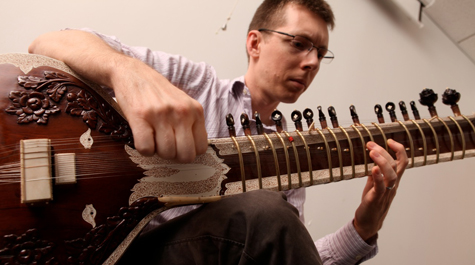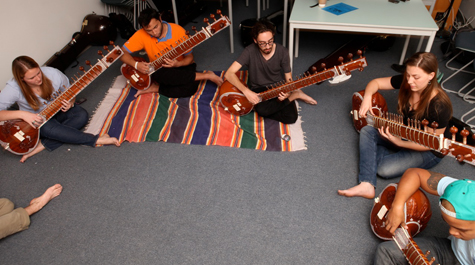New Indian music ensemble to perform first concert
A new world of sound has arrived at William & Mary, thanks to the College’s new Music of India Ensemble.
The seven students in the group, led by Assistant Professor Max Katz, have been learning how to play the sitar this semester in a one-credit class offered through the Department of Music. The ensemble will perform its first concert Nov. 12 at 8 p.m. in Ewell Recital Hall. The event is free and open to the public.
“This is part of the movement to increase the profile of South Asian culture on campus,” said Katz.
Katz, an ethnomusicologist, was hired at William & Mary because of his research on the music of India. Since he began at the College in 2009, he has been working toward starting a sitar ensemble. However, he said, purchasing eight sitars proved to be a challenge.
“All sitars are handmade,” he said. “There’s no such thing as a machine-made sitar. There’s no heavy machinery involved. They’re all made by guys sitting on the floor with bare feet, using hand tools. And they’re not standardized, so when you want a sitar, you really have to talk to the maker for a while about what you want.”
After four semesters at the College, Katz was finally able to obtain eight student sitars from a maker in Washington state with his own craftsmen working in India.
“There was a major adventure involved in getting the ensemble to finally come together,” he said. “And the whole time there were students knocking down my door.”
Although the ensemble did not begin until this semester, Katz has been teaching classes on the music of India, incorporating India into his Worlds of Music classes and giving talks around campus about the sitar and Indian music.
“That’s something a lot of students are interested in – not only Indian heritage students, but all kinds of students are fascinated by the instrument,” he said. “It looks something like a guitar, but you find out, even if you play guitar, the technique, the experience of playing it, the kind of callouses and toughness of fingers you need are all at another level.”
Katz said that he thinks that some of the interest in the sitar springs from its appearance and unique sound.
“That sort of grabs them,” he said. “That’s not a normal instrument sound. The fact that it has this buzz; that sound in itself can be gripping.”
There has also been an increased interest in India recently throughout the world, said Katz.
“India is such an important, rising power in the world,” he said. “Indian cultural practices have been spreading out from India for a long time, but I think because of India’s rising prestige in the world, more and more people are aware of India and Indian music today.”
Though in his other classes, Katz teaches about the culture and history of India and then focuses in on the music, with the sitar ensemble, he starts with the instrument and lets the learning blossom from there.
“We think of the sitar within a cultural orbit,” he said. “It’s not a stand-alone instrument. It’s not an instrument you can just pick up and play sounds on.”
The cultural world of Indian music begins to unfold as soon as students sit down with the sitar, Katz said.
“You have to sit on the floor, and the posture of playing the sitar requires taking off your shoes because you actually sit the gourd right on your bare foot,” he said. “So automatically, you’re participating in the cultural practice of taking off your shoes and sitting on the floor even to just start having a conversation about how to play the instrument.”
Katz said this method of instruction is common in the field of ethnomusicology.
“You’re going to study something foreign, something non-Western, but you’re going to very quickly realize that you can’t do that in the abstract,” he said. “You have to engage in the culture from which it comes in order to get the most out of it.”
The cultural learning comes organically as the students learn more about the instrument.
“The more deeply you get into the instrument, the more you learn about the music system, and the music system informs you about the larger culture in which it exists,” said Katz.
One of the things that students learn about Indian music is that practice is considered something like a form of penance.
“There are all these spiritual connotations and cultural support systems for practicing music, and there are all these ideas about the pain that you have to endure,” said Katz. “It’s not like Western music that's entirely focused on the intellectual experience -- instead it’s very much about enduring suffering as you practice.”
Though students can learn about that idea from a book, they begin to understand it on a deeper level when they start playing the sitar and forming deep callouses to hold the pick-like mizrab on their fingers.
“So all the students in the class are feeling the pain,” said Katz. “Now when they take the Music of South Asia class and start reading about riyaz, the ideology of practice, they will bring personal insight from having experienced it themselves. We believe that getting the hands-on experience informs the larger understanding of the culture and vice-versa.”
Though the students are suffering for their new art, they are enjoying the new instrument and have all committed to playing with the ensemble again next year, said Katz. But for now, they are looking forward to their first concert, in which they will demonstrate the improvisation and other techniques they’ve learned within the raga “Yaman.”
“Obviously, it’s all new for them, but I’m trying to guide them through it so they have the experience of what it means to play a concert,” said Katz.
Katz will also perform by himself at the end of the concert, accompanied by a guest tabla player. A tabla is a percussion instrument.
In addition to the ensemble increasing their knowledge and gaining experience through the concert, Katz hopes that the audience also gets something from the event.
“One of my hopes is that the audience will enjoy the music, and see that the music department at William & Mary is engaging with a lot of different musical systems and practices besides Bach, Beethoven and Brahms,” he said.
Although, traditionally, sitar players perform by themselves and not with seven others, Katz said that they are not trying to “represent the full gamut of sound, style and technique that goes into Indian classical music.”
“We are showing that, look, we have the ability to dip our toe into this vast ocean, and even just dipping your toe in will provide more than you can really assimilate all at once,” he said. “There’s just a massive, massive world of Indian music out there.”
















